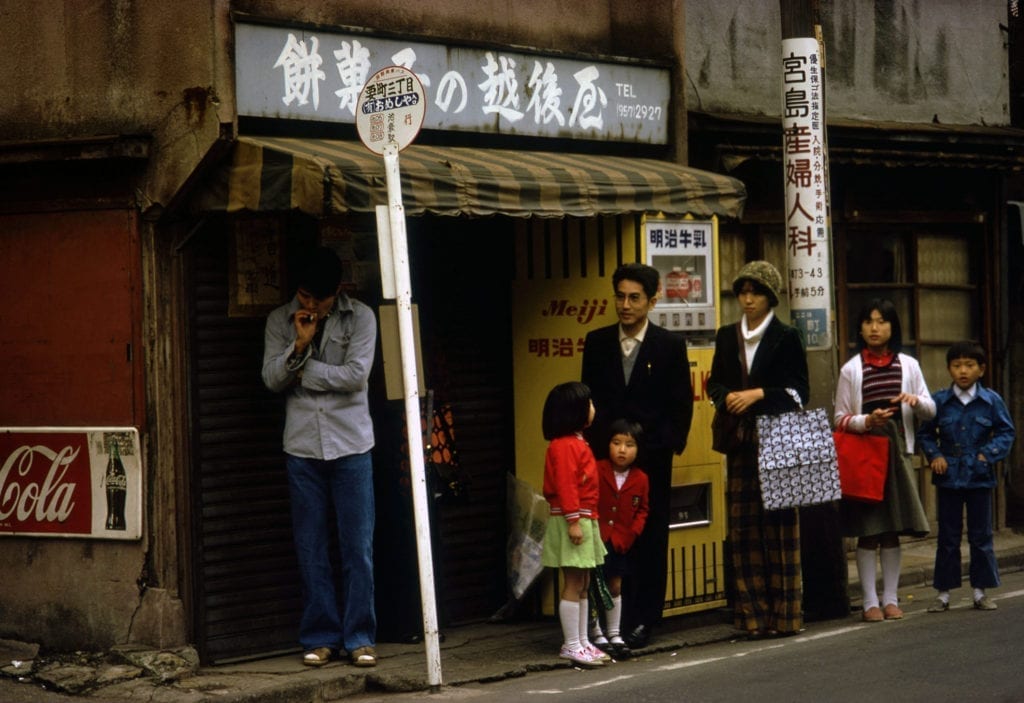Greg Girard’s interest in east Asia was cemented by a single image. Nestled in a Time-Life photography book, the still depicted a Hong Kong harbour – a modern skyline punctuated by traditional working ships. “The picture had things going on that made me want to visit.” remembers Girard. “It was this mixture of elements that did not belong together, but that this photographer had noticed and framed.” The overcast sky was infused by the glare of neon signs reminiscent of those in his hometown of Vancouver. “I was thinking about it later,” he continues. “The photograph made the exotic familiar and the familiar exotic.”
Restless and tiring of Vancouver, an eighteen-year-old Girard booked passage on a freighter travelling from San Francisco to Hong Kong. The photographer was struck by the density and verticality of the city: “The collision of things in the street”. So much was different, but so much was also the same. Instead of seeking out the extraordinary, Girard allowed himself to capture the familiar. “Rather than frame that out, I framed it in,” he reflects.


Despite being captivated by Hong Kong, the photographer returned home to Vancouver. And it was only on his second visit to east Asia in 1975 that Girard became interested in Tokyo. “I met this young Australian traveler in Brunei who described the city in ways I had never heard before, ” he remembers. The interaction compelled Girard to see Tokyo for himself. “The traveller described the mannered behaviour of train conductors – how they acted when trains arrive and depart – and the stylised mannerisms of women working in the department stores,” he recounts.
Returning to Vancouver again, Girard finally flew from Los Angeles to Tokyo in early 1976. His initial plan was to explore the city along with a number of other destinations. But, the moment the photographer arrived, he was bewitched. “It was just so obvious that it was a kind of science-fiction place – that word just popped into my head looking out the train window at the city,” he explains in the foreword to his book Tokyo-Yokosuka: 1976–1983, a collection of images from the two extended periods he spent living in the Japanese capital from 1976-77 and 1979-80. The publication is the third in a trilogy of photobooks, which collate work made during Girard’s teens through to his early-30s – Under Vancouver, 2017, features images of his home city made between 1972 and 82; and HK:PM, 2017, comprises work he made in Hong Kong from 1974 to 89.

Tokyo was the first foreign city that Girard explored in-depth. He had documented Vancouver extensively, using the metropolis as a canvas on which to develop his creative approach. Shooting with a 35mm camera, the photographer was drawn to the city’s downtown areas. Here, he captured dilapidated streets and houses, and their weary and hollow-eyed inhabitants. As he had done in Vancouver, Girard explored the city by walking. “It was a diaristic approach,” he says. “I had this real appetite for working the place out and trying to make it mine through photography … You walk the streets and attempt to translate them into a frame – in that way, you are kind of claiming the place.”
In 1976, Tokyo was far from the city that it has become. But, the capital was on the cusp of a transformation, and Girard recognised that. “It drew me in,” he says. “Although it was still hyper-modern it was not as widely-known. It had not yet graced the cover of Time magazine.” Following the OPEC oil shock of 1973, which left the country’s industrial sector in jeopardy, Japan’s leaders invested in the country’s emerging high-tech companies. The decision sparked the rapid growth of Sony, Toshiba, Sanyo, and Panasonic globally and transformed the country into an epicenter of modernity.


Girard’s images pay homage to a city in flux: streets teeming with people bathed in the iridescent glow of neon shop signs; young gangsters and suited businessmen frequenting the capital’s sordid nightlife districts; elegantly-dressed men and women in parks, bars, and an eclectic mix of domestic interiors. A new theme also emerged in Girard’s work during this time. On learning about the network of US bases that existed throughout Japan in the aftermath of World War II, the photographer was immediately intrigued. “I wondered what they looked like,” he remembers. “And on the weekends I began to take the train down to Yokosuka [a base about an hour southwest of Tokyo at the mouth of Tokyo Bay].” Girard discovered strange microcosms of America: “Worlds unto themselves”. The experience inspired the photographer’s interest in ‘base culture’ and the subject became a central theme in his work.
Girard left Japan in 1988. He was invited to accompany a BBC TV news crew on assignments as a sound recordist and took up the opportunity. “A lot of the work [from south-east Asia] was in boxes and did not get looked at until many, many years later,” he says. “At the time I was interested in making pictures for now and not thinking about posterity”. In hindsight, the photographer discovered details and elements that bore little significance at the time – the images accrued new meaning through the lens of history. Creating the book also posed its own challenges. “The difficulty with every publication is how to present, and sequence it, so that it feels right to me and the subject,” he says. “The test is whether it is interesting to the people from the place you are photographing.”
www.greggirardpictures.com





